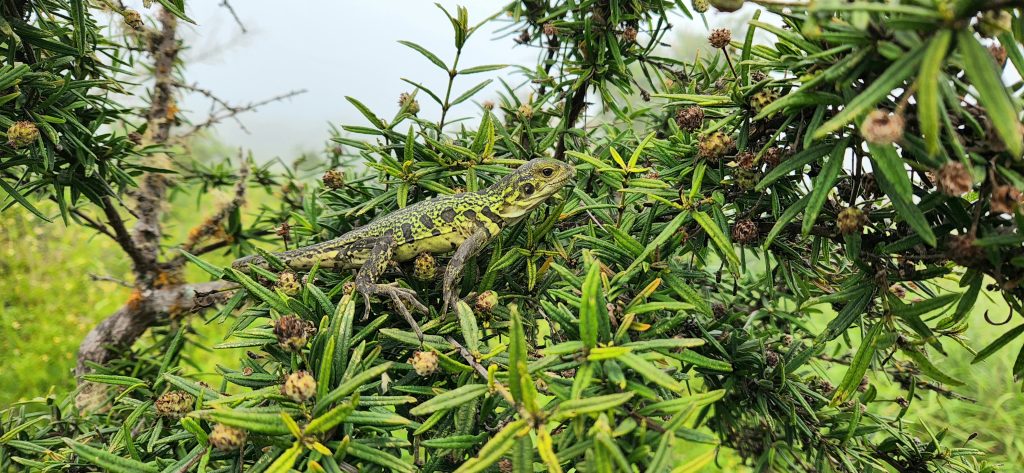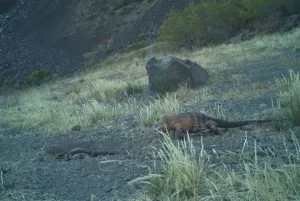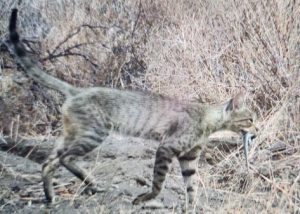
First-ever photos of juvenile Pink Iguanas showing characteristic striping © GNPD / Galápagos Conservancy

Photo of the first documented nesting site by Pink Iguanas © GNPD / Galápagos Conservancy
Since the “Galapagos Initiative” announced in October 2021 to bring together the efforts of the GNPD and the Galapagos Conservancy to help save the pink iguana, seven expeditions have been conducted to assess the current status and identify the threats facing the species; in recent months, the team documented nesting sites and detected active nests as well as hatchlings and juvenile iguanas of different ages.

Non-native feral cats preying on Pink Iguana hatchlings. © GNPD / Galápagos Conservancy
Genetic analysis to confirm the identification of juvenile pink iguanas is ongoing, while camera traps deployed by the team throughout the volcano have documented ample evidence of pink iguana mating and nesting activity, and even potential competition with conspecifics with whom they share Wolf Volcano’s habitat.
At the same time, there is great concern about the abundant presence of feral cats in the iguana’s living and nesting areas, representing a serious threat to these reptiles in their most critical and vulnerable phase, being currently considered one of the main causes for the lack of documented recruitment in the pink iguana population.
The Galapagos Initiative is now urgently focused on providing greater facilities for monitoring, research and protection of the pink iguana nesting areas through the implementation of a permanent station, funded by the Galapagos Conservancy, on the summit of the volcano with 360 degree visibility.
Danny Rueda, Director of the Galapagos National Park, thanked the Galapagos Conservancy for their support and assured that “this remote base will facilitate the conservation and monitoring work on the volcano, especially to guarantee the conservation and restoration of the pink iguana population”.
In Ecuador, the first case of Highly Pathogenic Avian Influenza H5 (HPAI) was reported in November 2022. It affected wild birds and poultry in particular. To contain this highly contagious virus, the Ecuadorian government declared the country a national emergency for 90 days. 180,000 birds were killed.
As part of efforts to stop the spread of the disease, the Ministry of Agriculture and Livestock has taken preventative measures to safeguard wild birds on Galapagos. They have also strengthened biosecurity measures on poultry farms in order to protect their production.
Danny Rueda is the director of Galapagos National Park. He stated in a press release by the MAG that permanent monitoring was set up in areas where there is the greatest influx of seabirds. Some of these birds are migratory and all visitor sites to ensure wildlife safety.
The Agency for the Regulation and Control of Biosecurity and Quarantine for Galapagos (ABG), issued Administrative Resolution No. 035, which prohibits fresh or frozen meats, eggs, and day-old chicks from entering the country. It also bans interisland movement and organisation of events involving a concentration avian species.
Galapagos Conservancy, together with Conservando Galapagos are vigilant in this health emergency. We offer our support to the Galapagos National Park Directorate, ABG, and any other needs that may arise on the archipelago.
The new book, “” by Millie Kerr (wildlife journalist) takes readers on an international exploration of innovative conservation initiatives led by passionate conservationists to save some of the most endangered species in the world.
Millie argues strongly for “rewilding,” a radical new approach in wildlife conservation that seeks to prevent the decline of species and to restore whole ecosystems through the repopulation of endangered species.
We are pleased that Iniciativa Galapagos (previously Giant Tortoise Restoration Initiative) is highlighted in “”. This partnership between Galapagos Conservancy (GNPD), and Galapagos National Park Directorate, (GNPD), emphasizes the role of Giant Tortoises for the recovery of Galapagos ecosystems.
Millie tells of the 50-person expedition that Washington Tapia, General Director at Conservando Galapagos and partner to Galapagos Conservancy led to find Giant Tortoises of unusual shell shapes. They were specifically looking for saddleback shells in contrast to the domed ones of the native Wolf Volcano. Tapia and his crew collected blood samples of 1,700 tortoises from the expedition. These were then sent to Yale. An analysis of blood samples revealed that the saddleback tortoises that were sighted in the area were a mix of Giant Tortoises and Wolf Volcani. This was many years later. Iniciativa Galapaos may now begin to reintroduce tortoise populations in Floreana, Pinta Islands using the same genetic makeup as centuries past.
Tapia stated, “We are proud to have Iniciativa Galapagos’ work recognized in the new book” and for our work in ecosystem restoration to be considered part of the solution.” Tapia stressed that the GNPD, Galapagos Conservancy and other organizations have been championing breeding giant tortoises and rewilding these Critically Endangered species for years.
Wilder’s success stories in conservation, like the one in Galapagos send a positive message at a critical moment in fighting biodiversity loss.
Galapagos Conservancy President Dr. Paul Salaman stated that “Iniciativa Galapagos is perhaps the most successful rewilding effort for any Critically Endangered species of Earth with a success rate exceeding 90% of young tortoises being repatriated into nature to ensure Giant Tortoises have an fighting chance of survival.”
Galapagos Conservancy has a commitment to the rewilding and conservation of the Galapagos Islands. The archipelago’s ecosystems have been affected by climate change, invasive species and overfishing. These pressing issues are being addressed in our efforts to ensure the long-term health of the Islands. Rewilding Giant Tortoises, the primary terrestrial ecosystem engineers, plays a crucial role.